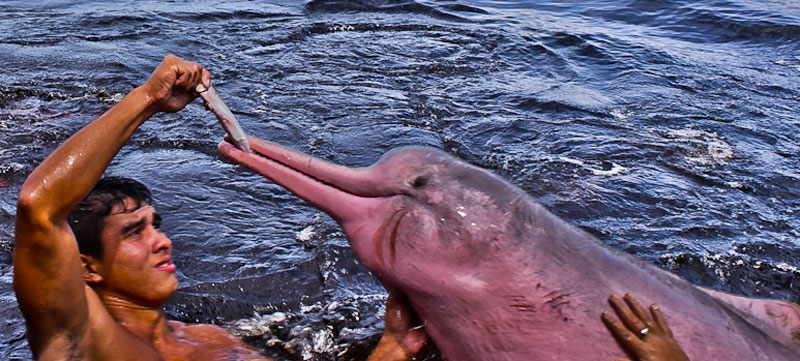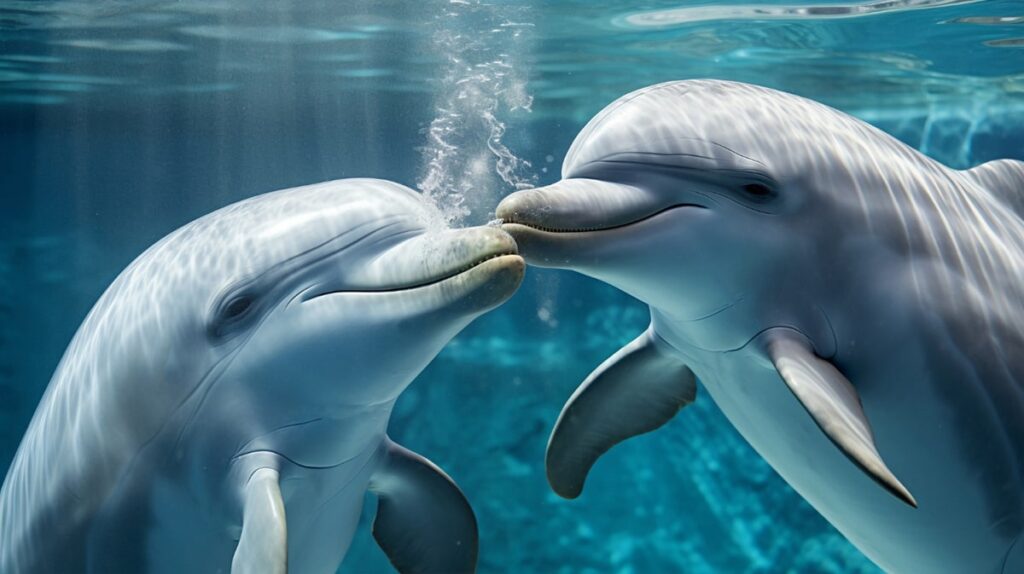1. Killer Dolphin

The headline may be a bit of an exaggeration, but it’s a fact that dolphins are used by the US and Russian governments for various military tasks.
The US even has a specific program for this purpose called the U.S. Navy Marine Mammal Program in San Diego, which includes 75 dolphins.
The program tested more than 19 different animal species (including some sharks and birds) and ultimately concluded that dolphins and sea lions are the most suitable animals. Dolphins are particularly useful due to their highly developed biosonar, while sea lions’ strength is their exceptional vision (underwater).
Although the exact functions of dolphins are military secrets, most speculation suggests that dolphins are used for the following tasks:
- Seek and destroy enemy submarines, ships, etc. using kamikaze methods
- Find foreign sea mines, divers, submarines, etc.
- Find injured divers
While the above tasks are not entirely factual – because they are secret – there is a good chance that dolphins are performing some of these tasks. The US Navy has confirmed that they use their dolphins to find sea mines, but denies that the dolphins are trained to harm humans or vessels.
Dolphins are also trained using the same principles as police and hunting dogs, where they are given a treat (such as a fish) when they perform a task correctly.
2. Pink dolphins

Not only are there pink dolphins, there are 2 types:
- Indo-Pacific humpback dolphin (Sousa chinensis) which lives in southeast Asia and northern Australia
- Amazon Dolphin (Inia geoffrensis) which lives in the river systems of the northwestern part of South America and is therefore found in the countries: Brazil, Peru, Bolivia, Ecuador, Colombia and Venezuela
However, pink dolphins are not pink throughout their lives; they are born black, change to gray and later to light red with gray spots while still young. As adults, they are white.
3. Dolphins commit suicide
Captive dolphins commit suicide – and they do it in a variety of ways, from refusing to eat to smashing their heads into walls!
Some biologists believe that this behavior is due to dolphins having difficulty adapting to new environments and feeding patterns. An example of this could be the difference between living in the open ocean and in a small, enclosed tank. Another example could be that dolphins in the wild are used to hunting and catching their own food, whereas in captivity they suddenly have it all “served” to them by humans.
For the record, not all dolphins that hit their heads on the wall commit suicide; they can get so excited or carried away by their play that they accidentally hit a wall, pool edge, etc. – in which case it’s more of an accident.
4. The world’s tallest man has saved 2 dolphins

The world’s tallest man saved in 2006 Two dolphins from death!
In an aquarium in the city of Fushun in northeastern China, two dolphins had swallowed pieces of plastic.
The vets had tried unsuccessfully to remove the pieces using instruments, which only caused the dolphins to contract their stomachs.
So they contacted the world’s tallest man, Bao Xishun, who used his long arms to remove most of the plastic pieces and save the poor dolphins.
5. The intelligence of dolphins

Metro-Goldwyn-Mayer – Wikipedia.org
Since the 1950s, most people have had a perception of dolphins as highly intelligent creatures. This is mainly due to the dolphins’ natural playful behavior, jumping, doing tricks and generally being very social and welcoming to humans.
In addition, the perception partly stems from the neurologist’s John Lilly’s experiments, where he attempted to communicate with dolphins using LSD, which – both at the time and today – is considered an extremely unscientific approach.
A third factor that contributes to our perception of dolphins as intelligent animals is their roles in various books and movies from recent decades. Good examples include the movies ‘Flipper’ and ‘Free Willy’.
Furthermore, some use the size of dolphins’ brains as an argument for their high intelligence:
- Human brain = 2% of our body weight
- Chimpanzee brain = 0.9% of body weight
- Elephant brain = 0.2% of body weight
- Dolphin brain = 0.9% of body weight
At first glance, you might think that dolphins are intelligent because they have relatively large brains – but can you compare the intelligence and brain size of aquatic and terrestrial animals?
One researcher has also highlighted that even a goldfish is smarter than a dolphin in some ways: If you put a goldfish in a bowl of water, it will immediately try to escape by jumping out of the bowl. However, if a dolphin is caught in a net, it will make no attempt to escape.
Today, there are therefore doubts about how intelligent dolphins are actually are and it would be wrong to assume that dolphins are intelligent just because we humans perceive them to be. Furthermore, our general knowledge of brain function – which includes intelligence – is still very limited. On top of that, we are not even able to measure our own intelligence properly!
6. Dolphin behavior

Dolphins are well known for their agility and playful behavior, making them some of the most popular aquatic animals in the world. Many species jump out of the water – even in a vertical position – to see the outside world, follow ships, swim synchronously, etc.
Dolphins live in social groups that can range in size from five to several hundred individuals (sometimes even thousands for short periods of time).
They use their bio-sonar to find their prey and often hunt in packs, surrounding schools of fish and alternating between swimming into the school and “helping themselves to the food”.
Dolphins also allow others to benefit from the fish they surround – including birds, whales and fishing boats. Similarly, there are also fishermen who cooperate with dolphins; the dolphins drive the fish towards the fishing boat and eat the fish that escape the fisherman’s net.
Dolphins mate throughout the year. The gestation period is 9-17 months depending on the species. As birth approaches, the female distances herself from the pod and heads for the surface. She usually gives birth to 1 calf per pregnancy – in rare cases, twins can also occur. The newborn dolphin nurses for 11 months to 2 years and stays with its mother until it is 3-8 years old.
7. Sleep

Dolphins living in the wildmust be conscious in order to breathe. This means they can’t sleep like humans, as they would suffocate! The dolphins’ “solution” to this is that they only allow one hemisphere of their brain to sleep at a time (this has been measured by scanning the dolphin brain).
There are basically 3 ways in which a dolphin can sleep:
- Swim very slowly and occasionally rise to the surface to draw air
- Float on the surface with the breathing hole above the water surface
- Staying on the bottom (only in shallow water) and occasionally swim to the surface for air
Dolphins sleep approximately 8 hours per day in these ways.
Dolphins in captivity can – unlike dolphins in the wild – sleep without being conscious and thus “shut down” both hemispheres of the brain.
Here, breathing is automatic and the dolphin’s tail moves reflexively to keep the breathing hole above the water surface if necessary.
8. The lifespan of dolphins

The most widespread and well-known dolphin species are urchin (Tursiops truncatus), also found in Nordic waters. Bottlenose dolphins live to a maximum age of 50 years.
However, the average lifespan varies greatly by species and habitat, and is calculated by a formula called ASR (Annual Survival Rate). For example, some dolphins live an average of 10 years, while others live 25 years. The average lifespan for all dolphins is estimated to be between 17 and 25 years.
The lifespan of individual dolphins can be determined for most species by analyzing the dolphin’s teeth.
Captive dolphins sometimes live slightly longer than dolphins in the wild because they are protected from predators, given medication, protected from pollution, etc. However, captive dolphins don’t live to a very old age (e.g. 50 years); this age is only achieved in the wild.
Other facts about dolphins
- Food: An adult dolphin eats 4-9% of its body weight in fish, squid and crustaceans every day. A dolphin weighing 250 kg therefore eats 10-22.5 kg of food per day
- Scuba diving: Dolphins can dive to a depth of 300 meters (at least that’s the deepest measurement for bottlenose dolphins)
- Salt and fresh water: Dolphins don’t drink saltwater, even though most of them live in it (it’s too salty!). Most of their fluids come from their food. Freshwater dolphins are primarily found in the Amazon (see ‘2. Pink dolphins’ above)
- Orcas: The killer whale (Orcinus orca) is a species of dolphin – in fact, the largest dolphin species in the world. Orcas can live up to 80 years old
- Communication: Dolphins communicate using sounds that to us sound like clicking or whistling
- Eradication: Some dolphin species are endangered – mainly due to fishing
- Teeth: Dolphins have 100 teeth – or more. However, they don’t use them to chew their food, but to catch and hold their prey


